
Today, the Lantz studio introduces a new comic foil for Woody Woodpecker!
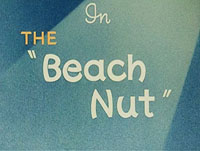 On paper, the concept for this cartoon seems thin, but director Shamus Culhane provides one of the finest usages of great character comedy in the Lantz cartoons. Woody’s first pairing with Wally Walrus involves escalating inadvertent (not deliberate, as a typical screwball character in 1940s cartoons would plan) circumstances that ruin Wally’s day off at the beach.
On paper, the concept for this cartoon seems thin, but director Shamus Culhane provides one of the finest usages of great character comedy in the Lantz cartoons. Woody’s first pairing with Wally Walrus involves escalating inadvertent (not deliberate, as a typical screwball character in 1940s cartoons would plan) circumstances that ruin Wally’s day off at the beach.
By the time The Beach Nut was in production, Culhane had established himself as a conductor of bold experiments for the studio. In his autobiography, Talking Animals and Other People, he recollected using a succession of montage cuts during the film’s finale, when the entire seaside pier collapses into the ocean. Culhane livened the ending with filmic and musical elements. “It was something like following a melodic line in music for a string quartet,” he stated. Evidently, the actions in the storyboards were vague. Culhane listened to the soundtrack multiple times and scribbled the action as what he thought were “meaningless doodles” – quickly jotted, geometric components to the music. This ingenious approach to animation distinguished him from the Lantz directors that preceded him.
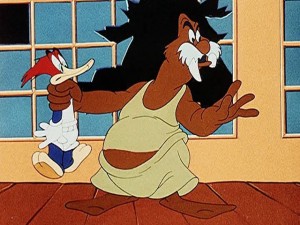 Amidst the beautiful drawing/movement he is noteworthy for, Emery Hawkins brings a nice touch of intricately staggered exposure in scene 40, where Woody shakes as Wally pounds on the table inside the fortune-teller tent. It’s surprising to see Dick Lundy’s expressive, cartoony animation in The Beach Nut, including Woody on his surfboard, is not as elegant as the look and feel of the Lantz shorts he directed.
Amidst the beautiful drawing/movement he is noteworthy for, Emery Hawkins brings a nice touch of intricately staggered exposure in scene 40, where Woody shakes as Wally pounds on the table inside the fortune-teller tent. It’s surprising to see Dick Lundy’s expressive, cartoony animation in The Beach Nut, including Woody on his surfboard, is not as elegant as the look and feel of the Lantz shorts he directed.
He also animates one of the weirdly drawn sequences in any cartoon, with Woody running up the camera, surfboard in hand. Don Williams’ brilliant timing is exploited in sequences such as Wally’s livid chopping of the fire hydrant where Woody takes refuge. The scene of giddy Wally, so jovial in finding a solution to catch Woody, bumping into a gong, inside the fortune-teller tent, has some fantastic character animation.
LaVerne Harding’s drawing/movement usually retained a constructed, dimensional quality. Her sequence of Woody in Wally’s swim trunks has some great timing. Harding is famous as the first female animator on the West Coast, with Fleischer animator Lillian Freidman predating her by a year. She was often credited as Verne Harding to appear as a male name. After attending Chouinard Art Institute, Harding drew a comic strip called “Cynical Susie” for United Feature Syndicate that originally ran from 1933-37. Harding drew the strip from 1933 to September 1935 before Bernard Dibble took it over. Susie’s character appears in the 1933 Oscar-nominated Oswald Rabbit, The Merry Old Soul.She was first credited for her animation at Lantz in 1934 and continued there until 1959. When the studio re-opened around 1950, after its brief closure, she re-designed Woody in a definitive version that remains in use today. She quit Lantz to work for Hanna-Barbera, and switched back to theatricals for DePatie-Freleng. She moved to Warner Bros. in the late ‘60s, where she stayed until the animation division shut down in 1969. Harding finished her career at Filmation. Lantz valued her animation skill, and what she brought to his characters. When he learned about her death in 1984, he remarked, “Most producers thought women could draw only birds and bees and flowers. They were wrong, of course.”
Paul Smith’s animation in The Beach Nut is serviceable, but his drawing doesn’t share the vitality that his other artists bring. One of Disney’s first Hollywood employees, he started as a cel painter in August 1926. He left the studio for a brief period on February 10, 1927, but returned on April 2nd. He was among many artists that signed with Charles Mintz to migrate with Oswald the Rabbit. When Winkler’s studio folded, Smith animated for Harman-Ising at Schlesinger’s, but stayed when they left, and remained there until the late ‘30s. He progressed to Lantz in the early ‘40s, and stayed there for most of his career. Smith animated on Bob Clampett’s 1946 Republic cartoon, It’s a Grand Old Nag, and briefly animated for UPA when Lantz’s studio closed. He returned as an animator when Lantz re-opened and became a director by 1952. By 1967, he became the studio’s sole director until 1972, when the studio closed.
Layout artist Art Heinemann’s splendid orange beach skies and the solid black backgrounds inside the fortune-teller tent are another facet of this cartoon’s distinctiveness. Heinemann began as a layout artist on Harman-Ising’s Happy Harmonies for MGM, then became a layout and story sketch artist for Disney on the Silly Symphonies, Pinocchio and Fantasia, with no credit. He worked free-lance at the Lantz studio from June 1943 to September 1944. Heinemann dropped by at the studio to receive assignments from Culhane. He designed the layouts at home and delivered the finished work to the director.
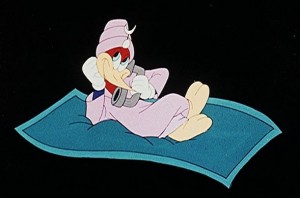 He worked in Chuck Jones’ unit at Warner Bros. in two consecutive stints during the ‘40s, designing characters for model sheets. Heinemann was also responsible for the RKO stop-motion Daffy Ditty series during the late ‘40s. He worked on another obscure series, Republic Pictures’ animated Jerky Journeys series with Warners background artists Pete Alvarado and Paul Julian. He ended up at MGM in the ‘50s, but Fred Quimby fired him soon after Dick Lundy was in the directing chair. He moved on to UPA, and later emigrated to John Sutherland’s studio.
He worked in Chuck Jones’ unit at Warner Bros. in two consecutive stints during the ‘40s, designing characters for model sheets. Heinemann was also responsible for the RKO stop-motion Daffy Ditty series during the late ‘40s. He worked on another obscure series, Republic Pictures’ animated Jerky Journeys series with Warners background artists Pete Alvarado and Paul Julian. He ended up at MGM in the ‘50s, but Fred Quimby fired him soon after Dick Lundy was in the directing chair. He moved on to UPA, and later emigrated to John Sutherland’s studio.
The “final check” draft for Beach Nut shares a quandary with Culhane’s Abou Ben Boogie document. The draft is misleading in its scene assignments. The animators listed often don’t match up with certain traits of the work on-screen. For example, scene 3, with Woody running with the surfboard, credited to Harding, doesn’t match her solidity. It’s most obviously Lundy’s style. Scene 13, described as “Woody’s drum-break,” does not seem to occur in the finished cartoon, but Lantz mainstay Les Kline receives credit. Scene 16 of Woody frying a hot dog, following Wally popping out of the sand (sc. 14), with the hourglass eyes gag (sc. 15) originally happened after, as listed in the draft. Some of the assignments in the draft are left blank or have artist’s names crossed out. There are credits attached in the video, except for the establishing shot of the beach and crowd shots at the start of the cartoon.
It’s hot enough this month for a day by the sea, by the sea, by the beautiful sea… Enjoy this week’s breakdown!
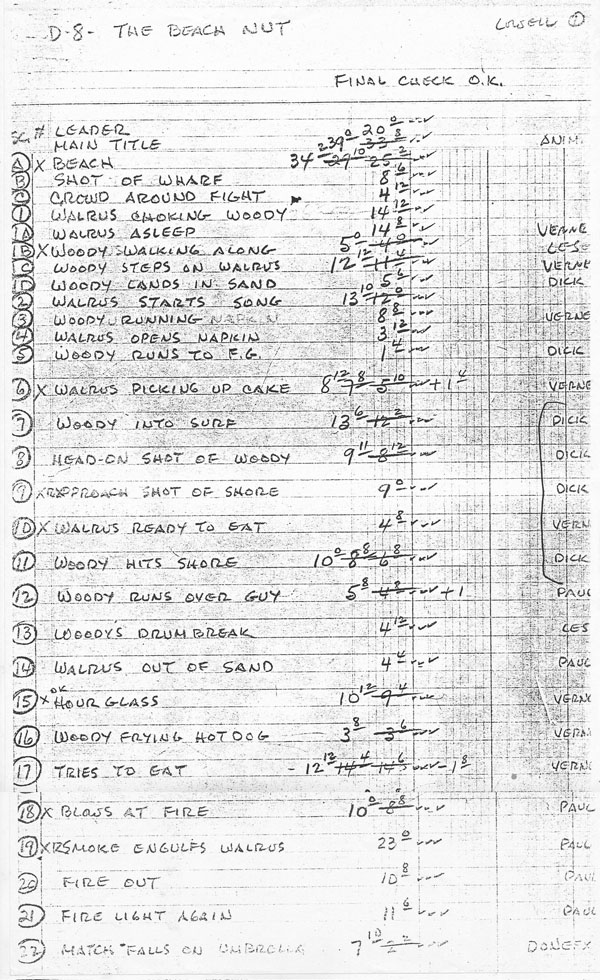
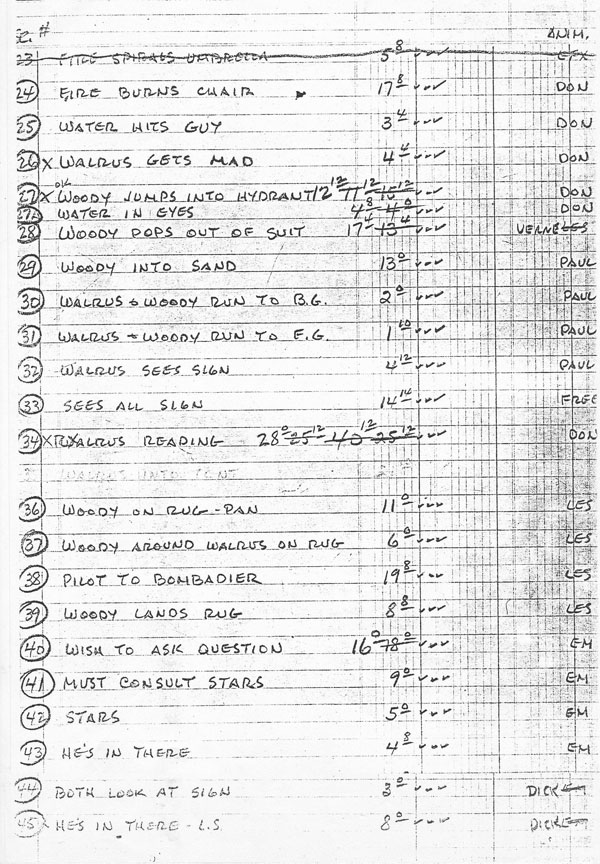
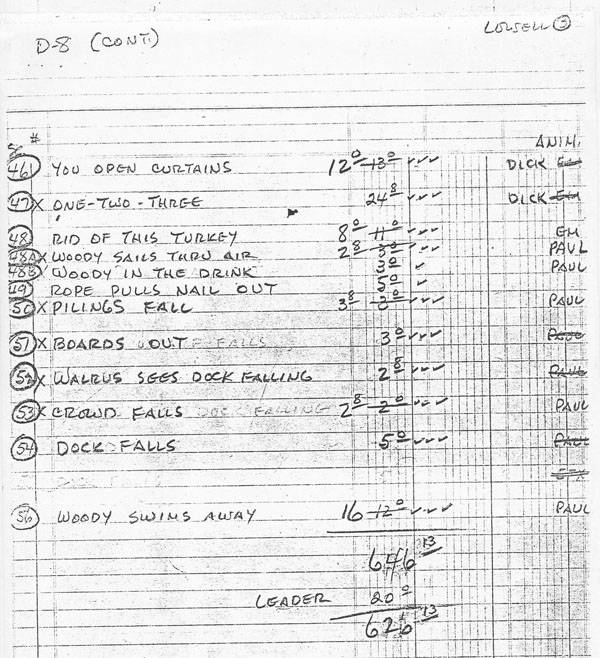



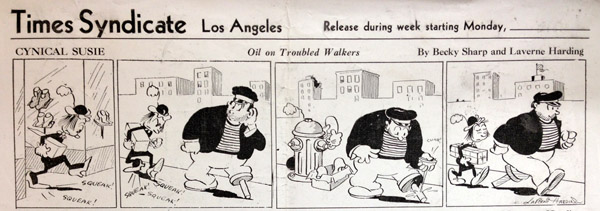
 DEVON BAXTER is a film restoration artist, video editor, and animation researcher/writer currently residing in Pennsylvania. He also hosts a
DEVON BAXTER is a film restoration artist, video editor, and animation researcher/writer currently residing in Pennsylvania. He also hosts a 





















































































I liked how the cartoon opened with Wally saying “I guess you think I’m trying to kill this turkey? Well, I am! And here’s why…” Evidently not only does the crowd listen to his story, they all apparently didn’t mind that Wally followed through with his plans for murder.
The loose descriptions in the draft are also amusing, especially “Rid of this turkey”, “Woody sails thru the air”, “Woody in the drink”
Also the unintentional “Walrus Choking Woody”
The Lantz studio really took a big step up graphically with the arrival of Culhane and others from Disney and Warners. (You only wish the other Warners vet, Ben Hardaway, could have stepped up his game more often in the ensuing six years).
The idea of giving Wally a Swedish accent completes the package of him being Elmer Fudd to Woody’s Bugs/Daffy, just as Lundy would later create Buzz Buzzard to be Woody’s Yosemite Sam and allow even harder gags against Woody’s opponent (as with Friz Freleng’s complaint about Elmer’s passivity, you’d almost feel sorry for Wally when he’d fall victim to a really physical gag by Woody).
Agreed. Good insights there.
Another fun post! Keep up the great work, Devon!
Excellent work as always! Lot of beautifully insane animation in this one: Dick Lundy’s animation is especially wonderful in its’ movement.
Probably the biggest surprise for me is learning what Paul Smith animated. Not only did I crack up at his Wally walk cycles, but I was shocked it’s was him who animated that finale Shamus talked about. Makes me wonder what else he’s done that is worth our attention.
Yes, the Paul Smith material is very competent stuff here. Makes me think he was much better as an animator than a director.
Interesting that Smith started at Disney, who later hired another Paul J. Smith – a composer.
On the Snow White And The Seven Dwarfs IMDb page, I remember they accidentally listed the animator Paul Smith instead of the composer for a while.
As much as I like this cartoon, it’s obvious that not all of Woody’s mayhem is inadvertent. He enjoys tormenting Wally, especially in the swami segment. A better example of the oblivious Woody would be the Lundy-directed “Bathing Buddies”, in which, in his obsession with finding his lost dime, he doesn’t realize he’s destroying the entire apartment complex.
Who choose the animators? The director or walter lantz?